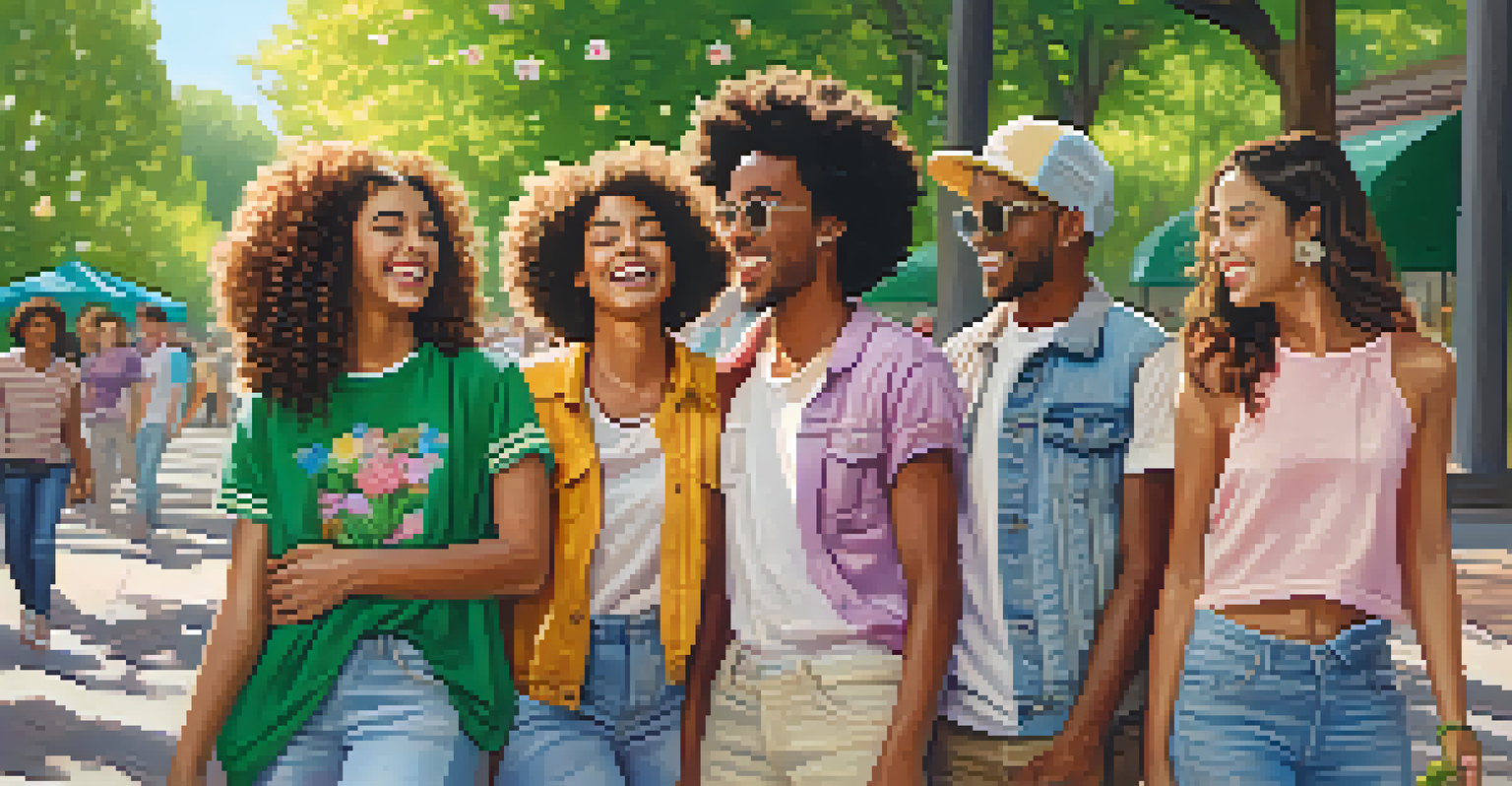How Clothing Influences Group Dynamics and Social Interactions

The Role of Clothing in First Impressions
Clothing is often our first point of contact in social situations. It can convey a wealth of information about a person’s identity, status, and attitude before any words are spoken. For example, someone dressed in a tailored suit might be perceived as more authoritative than someone in casual attire, setting the stage for how they are treated.
Clothes mean nothing until someone lives in them.
First impressions matter, and studies show that people make snap judgments about others based on their clothing. This initial assessment can influence how individuals interact and engage with one another, often shaping future conversations and relationships. It's fascinating how a simple outfit can open or close doors.
This dynamic underscores the importance of dressing appropriately for different contexts. Whether it’s a job interview, a social gathering, or a casual meet-up, understanding the unspoken rules of attire can help individuals navigate social landscapes more effectively.
Clothing as a Social Identifier
Clothing often serves as a badge of belonging to a particular group. Whether it’s through team jerseys, fashion trends, or cultural attire, what we wear can signal our affiliations and identities. For instance, wearing a band t-shirt at a concert immediately connects you with fellow fans, fostering camaraderie.

This shared identity can enhance group dynamics, creating a sense of unity and belonging. When people dress similarly, it can lead to stronger social bonds and a feeling of being part of something larger than oneself. It’s like wearing a uniform that says, 'I’m part of this tribe.'
Clothing Shapes First Impressions
Our attire can convey identity and influence how we are perceived before we even speak.
Conversely, clothing can also set individuals apart, highlighting differences within a social setting. When someone dresses distinctly from the group, it may create barriers or even spark curiosity, leading to varied interactions based on perceptions of individuality versus conformity.
The Psychological Impact of Clothing Choices
Our clothing choices can significantly impact our mood and behavior. When we dress in a way that makes us feel confident and comfortable, it often reflects in our interactions with others. For example, wearing bright colors can elevate your mood and make you more approachable in social settings.
You can never be overdressed or overeducated.
Conversely, clothing that feels restrictive or uncomfortable can lead to self-consciousness, affecting how you engage with those around you. This psychological connection between our attire and our mindset can influence group dynamics, as a confident individual may inspire others to interact more openly.
This phenomenon is known as 'enclothed cognition,' where the clothes we wear influence our psychological state. Understanding this concept can empower individuals to make clothing choices that enhance their social experiences and interactions.
Fashion Trends and Group Behavior
Fashion trends can act as a social glue, bringing people together around shared styles and tastes. When a new trend emerges, it often creates a buzz that encourages individuals to adopt similar looks, fostering connections through shared experiences. Think of how everyone sports the latest sneaker craze or adopts a viral TikTok fashion.
These trends can also create an 'in-group' versus 'out-group' dynamic, where those who follow the trend feel a sense of belonging, while those who don’t may feel excluded. This can lead to both positive and negative group behaviors, where conformity is celebrated, but individuality may be stifled.
Fashion Connects and Divides Groups
Trends can foster connections among those who embrace them while potentially alienating others.
Moreover, trends can evolve quickly, prompting groups to constantly adapt and redefine their identities. This cycle of changing fashions can keep social interactions fresh and dynamic, as people navigate the ever-shifting landscape of what's considered 'in vogue.'
Cultural Clothing and Social Interactions
Cultural attire often plays a significant role in social interactions, offering insights into heritage and values. Wearing traditional garments can evoke pride and facilitate connections among those who share similar backgrounds. For example, donning a kimono at a Japanese festival can enhance communal bonds and foster a sense of belonging.
However, the cultural significance of clothing also calls for sensitivity and respect. When individuals from outside a culture adopt traditional attire, it can lead to misunderstandings or accusations of appropriation. It’s crucial for people to navigate these interactions thoughtfully, recognizing the deeper meanings behind what others wear.
Understanding the cultural context of clothing can enrich social interactions, encouraging appreciation and dialogue rather than division. It allows for a greater appreciation of diversity, as individuals learn from each other’s clothing choices and the stories they tell.
The Impact of Uniforms on Group Dynamics
Uniforms are a powerful example of how clothing influences group dynamics, often fostering a sense of equality and teamwork. In environments like schools or workplaces, uniforms can minimize distractions and create a focus on collective goals rather than individual appearances. This can enhance collaboration and reduce competition among group members.
Additionally, wearing uniforms can instill a sense of pride and belonging, as individuals feel they are part of a cohesive unit. Just think of sports teams—when players wear their team colors, it not only sets them apart but also solidifies their identity as a part of that group.
Uniforms Foster Team Dynamics
Wearing uniforms can promote equality and teamwork, but may also limit personal expression.
However, uniforms can also have drawbacks, as they may suppress individual expression. Striking a balance between uniformity and personal style is essential for fostering a positive atmosphere where everyone feels valued and included.
Clothing and Social Hierarchies
Clothing often reflects and reinforces social hierarchies, influencing how individuals perceive each other within a group. Higher-end fashion brands can create an association with status and wealth, which may lead to preferential treatment in social situations. For instance, someone wearing designer labels might receive more attention compared to someone in thrift store finds.
This dynamic can create a sense of exclusivity, where those who align with certain fashion norms may feel superior, while others may feel marginalized. Such hierarchies can impact group interactions, as individuals navigate the complexities of social status through their clothing choices.

Understanding these social cues is vital for fostering inclusive environments. By recognizing the influence of clothing on social hierarchies, individuals and organizations can work towards creating spaces that celebrate diversity and minimize divisions.